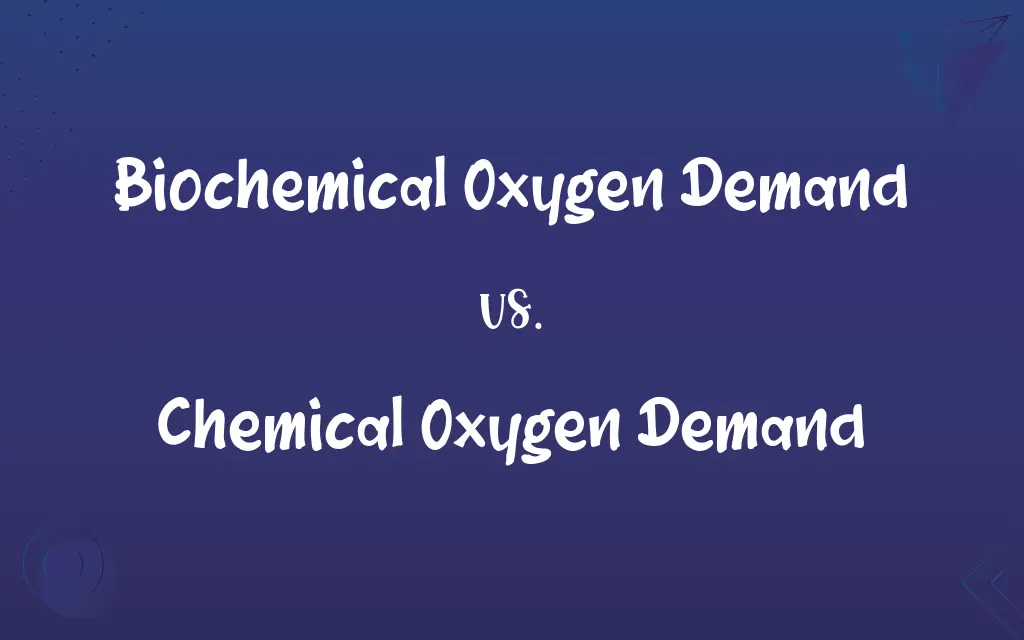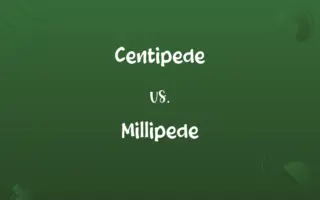Biochemical Oxygen Demand vs. Chemical Oxygen Demand: Know the Difference

By Shumaila Saeed || Published on January 31, 2024
Biochemical Oxygen Demand (BOD) measures oxygen required by microorganisms to decompose organic matter in water, while Chemical Oxygen Demand (COD) gauges oxygen needed to chemically oxidize pollutants.

Key Differences
Biochemical Oxygen Demand (BOD) is a measure of the amount of oxygen that microorganisms, such as bacteria, require to decompose organic matter in water. This is an important indicator of water quality, reflecting the level of organic pollution. Chemical Oxygen Demand (COD), on the other hand, quantifies the amount of oxygen needed to oxidize all pollutants, both organic and inorganic, in water through chemical reactions. COD is often higher than BOD, as it includes substances that bacteria can't decompose.
Shumaila Saeed
Jan 31, 2024
BOD primarily focuses on the biological decomposition of organic matter, making it a more specific indicator of biodegradable organic pollutants in water bodies. It is crucial for assessing the impact of effluents on aquatic ecosystems. COD, in contrast, encompasses the total chemical oxidation of all substances in the water. This makes COD a quicker and more comprehensive assessment of water pollution, including pollutants that are not biologically degradable.
Shumaila Saeed
Jan 31, 2024
The testing method for BOD involves incubating a water sample for five days at 20°C and measuring the decrease in oxygen levels. This reflects the oxygen consumed by microorganisms during decomposition. For COD, the process is much faster, involving the addition of a strong chemical oxidant to the water sample and measuring the resultant change in oxygen content, which can be completed in a few hours.
Shumaila Saeed
Jan 31, 2024
BOD is particularly significant in evaluating the effect of sewage and effluent discharge on rivers and lakes. It helps in understanding the level of organic pollution and its potential impact on aquatic life. Conversely, COD is more frequently used in industrial contexts, where it helps monitor and control waste that contains chemical pollutants, not just organic matter.
Shumaila Saeed
Jan 31, 2024
Lastly, while BOD is an indirect measure of organic pollution and requires a longer time to provide results, it is essential for environmental monitoring and regulation. COD, with its broader scope and rapid testing method, is more practical for industrial applications where time and a comprehensive assessment of all types of pollutants are critical.
Shumaila Saeed
Jan 31, 2024
ADVERTISEMENT
Comparison Chart
Definition
Oxygen required by microorganisms to decompose organic matter in water
Oxygen needed to chemically oxidize all pollutants in water
Shumaila Saeed
Jan 31, 2024
Focus
Biological decomposition of organic matter
Chemical oxidation of all substances, organic and inorganic
Shumaila Saeed
Jan 31, 2024
Measurement Method
Incubation for 5 days at 20°C, measuring oxygen depletion
Addition of a chemical oxidant and measuring oxygen change
Shumaila Saeed
Jan 31, 2024
Application
Assessing organic pollution impact on aquatic ecosystems
Monitoring and controlling waste in industrial settings
Shumaila Saeed
Jan 31, 2024
Significance and Practicality
Essential for environmental monitoring, longer process
Broader scope, rapid process, suited for industrial pollution control
Shumaila Saeed
Jan 31, 2024
ADVERTISEMENT
Biochemical Oxygen Demand and Chemical Oxygen Demand Definitions
Biochemical Oxygen Demand
BOD measures water's oxygen level depletion due to microbial decomposition of organic material.
High BOD in a river indicates significant organic pollution, affecting aquatic life.
Shumaila Saeed
Jan 11, 2024
Chemical Oxygen Demand
COD measures the total quantity of oxygen required to oxidize all soluble and particulate organic material in water.
High COD values in industrial wastewater indicate the presence of hard-to-treat pollutants.
Shumaila Saeed
Jan 11, 2024
Biochemical Oxygen Demand
BOD is the oxygen required by aerobic biological organisms to decompose organic material in water.
Low BOD in a lake signifies a healthier ecosystem with less organic pollution.
Shumaila Saeed
Jan 11, 2024
Chemical Oxygen Demand
COD indicates the amount of oxygen required to break down pollutants chemically in water.
Elevated COD in a stream can signify a wide range of pollutants, including toxic chemicals.
Shumaila Saeed
Jan 11, 2024
Biochemical Oxygen Demand
BOD quantifies the oxygen demand of microorganisms to break down organic compounds in water.
The BOD level helps in assessing the effectiveness of waste treatment processes.
Shumaila Saeed
Jan 11, 2024
ADVERTISEMENT
Chemical Oxygen Demand
COD is a measure of water's chemical load, indicating the degree of pollution by various substances.
A spike in COD can alert authorities to potential industrial spills or contamination.
Shumaila Saeed
Jan 11, 2024
Biochemical Oxygen Demand
BOD is used to gauge the degree of pollution by organic substances in water bodies.
Municipalities test BOD in rivers to regulate industrial discharge.
Shumaila Saeed
Jan 11, 2024
Chemical Oxygen Demand
COD is a chemical procedure to determine water pollution by quantifying oxygen demand for oxidation.
COD testing is crucial for ensuring treated water from factories meets environmental standards.
Shumaila Saeed
Jan 11, 2024
Biochemical Oxygen Demand
BOD is an ecological indicator of the amount of biodegradable organic matter in water.
A wastewater treatment plant monitors BOD to ensure effluents don't harm the environment.
Shumaila Saeed
Jan 11, 2024
Chemical Oxygen Demand
COD encompasses the oxygen consumption for oxidizing both organic and inorganic substances in water.
COD levels are monitored in chemical plants to assess the impact of their effluents.
Shumaila Saeed
Jan 11, 2024
Repeatedly Asked Queries
What does a low BOD indicate about water quality?
Low BOD suggests low levels of organic pollution and better water quality.
Shumaila Saeed
Jan 31, 2024
What does COD measure in water?
COD measures the amount of oxygen needed to chemically oxidize all pollutants in water.
Shumaila Saeed
Jan 31, 2024
Why is COD testing faster than BOD testing?
COD uses chemical oxidants for immediate results, unlike the biological process of BOD.
Shumaila Saeed
Jan 31, 2024
How is BOD important for environmental health?
High BOD levels can deplete oxygen in water, harming aquatic life.
Shumaila Saeed
Jan 31, 2024
What does BOD measure in water?
BOD measures the oxygen required by microorganisms to decompose organic matter in water.
Shumaila Saeed
Jan 31, 2024
What is the primary application of BOD?
BOD is primarily used to assess the impact of sewage and wastewater on aquatic environments.
Shumaila Saeed
Jan 31, 2024
How long does BOD testing typically take?
BOD testing usually takes five days to complete.
Shumaila Saeed
Jan 31, 2024
Can BOD testing detect inorganic pollutants?
No, BOD specifically measures biodegradable organic matter.
Shumaila Saeed
Jan 31, 2024
Is COD a better indicator of pollution than BOD?
COD provides a broader measure of pollution but may include non-biodegradable substances.
Shumaila Saeed
Jan 31, 2024
Does BOD always correlate with COD?
No, BOD and COD can differ significantly, especially with non-biodegradable pollutants.
Shumaila Saeed
Jan 31, 2024
How does COD differ from BOD in terms of pollutants detected?
COD detects both organic and inorganic pollutants, unlike BOD.
Shumaila Saeed
Jan 31, 2024
Is BOD or COD more significant for ecological assessments?
BOD is more significant for ecological assessments due to its focus on biodegradable matter.
Shumaila Saeed
Jan 31, 2024
How does COD help in environmental compliance?
COD levels help industries comply with environmental regulations regarding water pollution.
Shumaila Saeed
Jan 31, 2024
Can high COD levels affect water treatment processes?
Yes, high COD levels can indicate difficult-to-treat pollutants in water.
Shumaila Saeed
Jan 31, 2024
Can COD testing be used to monitor industrial discharge?
Yes, COD is used to monitor and control industrial wastewater discharge.
Shumaila Saeed
Jan 31, 2024
What industries commonly use COD testing?
COD testing is common in industries with chemical and non-biodegradable waste.
Shumaila Saeed
Jan 31, 2024
How do temperature and pH affect COD testing?
High temperatures and varying pH can influence the chemical reactions in COD testing.
Shumaila Saeed
Jan 31, 2024
Can both BOD and COD be used for drinking water testing?
They are more relevant for wastewater; drinking water typically has low BOD and COD.
Shumaila Saeed
Jan 31, 2024
What factors can affect BOD levels in water?
Factors include the amount of organic matter, temperature, and microbial activity.
Shumaila Saeed
Jan 31, 2024
What role does BOD play in wastewater treatment?
BOD levels indicate the effectiveness of wastewater treatment processes.
Shumaila Saeed
Jan 31, 2024
Share this page
Link for your blog / website
HTML
Link to share via messenger
About Author
Written by
Shumaila SaeedShumaila Saeed, an expert content creator with 6 years of experience, specializes in distilling complex topics into easily digestible comparisons, shining a light on the nuances that both inform and educate readers with clarity and accuracy.









































































